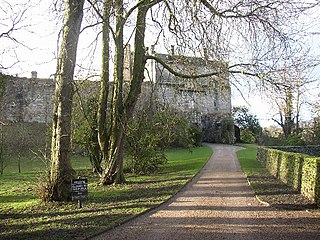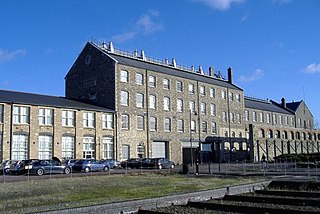Related Research Articles

English Heritage is a charity that manages over 400 historic monuments, buildings and places. These include prehistoric sites, medieval castles, Roman forts and country houses.

In the United Kingdom, a scheduled monument is a nationally important archaeological site or historic building, given protection against unauthorised change.

Cadw is the historic environment service of the Welsh Government and part of the Tourism and Culture group. Cadw works to protect the historic buildings and structures, the landscapes and heritage sites of Wales, to make them available for the public to visit, enjoy, and understand their significance. Cadw manages 127 state-owned properties and sites. It arranges events at its managed properties, provides lectures and teaching sessions, offers heritage walks, and hosts an online shop. Members of the public can become members of Cadw to gain membership privileges.

In the United Kingdom a listed building is a structure of particular architectural and/or historic interest deserving of special protection. Such buildings are placed on one of the four statutory lists maintained by Historic England in England, Historic Environment Scotland in Scotland, Cadw in Wales, and the Northern Ireland Environment Agency in Northern Ireland. The term has also been used in the Republic of Ireland, where buildings are protected under the Planning and Development Act 2000, although the statutory term in Ireland is "protected structure".

The Society for the Protection of Ancient Buildings (SPAB) is an amenity society founded by William Morris, Philip Webb, and others in 1877 to oppose the destructive 'restoration' of ancient buildings occurring in Victorian England. "Ancient" is used here in the wider sense rather than the more usual modern sense of "pre-medieval."
The Register of Historic Parks and Gardens of Special Historic Interest in England provides a listing and classification system for historic parks and gardens similar to that used for listed buildings. The register was set up by Historic England under the provisions of the National Heritage Act 1983. Over 1,600 sites are listed, ranging from the grounds of large stately homes to small domestic gardens, as well other designed landscapes such as town squares, public parks and cemeteries. The register is published on the National Heritage List for England alongside other national heritage designations.

The Priory Church of St James, Bristol, is a Grade I listed building in Horsefair, Whitson Street.

Wothorpe is a village and civil parish in the Peterborough unitary authority of Cambridgeshire, England. It is in the far north-west of the district, and to the south of Stamford. The parish borders Northamptonshire to the west.

Cockermouth Castle is in the town of Cockermouth in Cumbria on a site by the junction of the Rivers Cocker and Derwent. It is a Grade I listed building and a scheduled monument.

The Historic England Archive is the public archive of Historic England, located in The Engine House on Fire Fly Avenue in Swindon, formerly part of the Swindon Works of the Great Western Railway.

The Buildings at Risk Register for Scotland records buildings of national architectural or historic interest which are considered to be under threat. The list is maintained by Historic Environment Scotland (HES). The register was established in 1990, with the purpose of raising awareness of the threats to Scotland's built heritage. It was maintained by the Scottish Civic Trust until 2011, then by RCAHMS until that body became part of HES in 2015.

Newark Priory is a ruined priory on an island surrounded by the River Wey and its former leat near the boundary of the village of Ripley and Pyrford in Surrey, England.
Historic England is an executive non-departmental public body of the British Government sponsored by the Department for Culture, Media and Sport. It is tasked with protecting the historic environment of England by preserving and listing historic buildings, scheduling ancient monuments, registering historic parks and gardens and by advising central and local government.
Registered Battlefields in the UK are battlefields recognised as having specific historic or cultural significance. They are recognised as such by conservationist organisations for a variety of reasons, including protecting them from development that may threaten historic buildings, items, or topography. The history relating to them is often hard to unravel, as there is often little to see above ground and the historical record is often biased in favour of the victors. The UK has many historic battlefield sites, some of which have legal protection through heritage protection legislation whilst others are protected through landscape legislation. More recently, some archaeologists prefer the term "site of conflict" to "battlefield", because of the difficulty in defining the geographical extent of a site.
The National Heritage List for England (NHLE) is England's official database of protected heritage assets. It includes details of all English listed buildings, scheduled monuments, register of historic parks and gardens, protected shipwrecks, and registered battlefields. It is maintained by Historic England, a government body, and brings together these different designations as a single resource even though they vary in the type of legal protection afforded to them. Although not designated by Historic England, World Heritage Sites also appear on the NHLE; conservation areas do not appear since they are designated by the relevant local planning authority.
A heritage asset is an item that has value because of its contribution to a nation's society, knowledge and/or culture. They are usually physical assets, but some countries also use the term in relation to intangible social and spiritual inheritance. The term is found in several contexts:
Designation is the act of setting aside something, or devoting it to a particular purpose. In the legal planning context, it is also "the action of choosing a place for a special purpose or giving it a special status".

Charterhouse, Coventry is a grade I listed building on London Road, Coventry, in the West Midlands of England.

Bourn Windmill is an open trestle post mill at Bourn in Cambridgeshire, England, which was standing in 1636. It is a Grade I Listed building and a Scheduled Monument. It is the oldest surviving windmill in the United Kingdom. The mill ceased work commercially in 1927 and was preserved in 1932. In November 2021, it was placed on the Heritage at Risk Register as being in danger of collapse.
References
- 1 2 3 4 "Heritage at Risk methodology statement" . Retrieved 2 September 2018.
- ↑ "Heritage at Risk 2010 Regional Registers" . Retrieved 2 June 2011.
- ↑ "Local Authority Registers" . Retrieved 17 October 2011.
- ↑ "Heritage at Risk". Archived from the original on 24 July 2011. Retrieved 2 June 2011.
- ↑ "Heritage at Risk Register" . Retrieved 2 June 2011.
- ↑ "Buildings at Risk" . Retrieved 17 October 2011.
- ↑ "Home Page | SAVE Britain's Heritage". www.savebritainsheritage.org.
- ↑ Kennedy, Maev (25 July 2007). "The stately wrecks of England". The Guardian. London. Retrieved 4 May 2015.
- ↑ "What is Heritage at Risk?" . Retrieved 2 June 2011.
- ↑ "Conservation Areas at Risk" . Retrieved 12 May 2015.
- ↑ "Caring for Places of Worship" . Retrieved 12 May 2015.
- ↑ "Heritage at Risk" . Retrieved 2 June 2011.
- ↑ "Funding of the arts and heritage — Culture, Media and Sport Committee" . Retrieved 2 June 2011.
- ↑ "Heritage at Risk 2014 national summary leaflet" (PDF). English Heritage. 23 October 2014. Retrieved 4 May 2015.
- ↑ "Buildings at Risk" . Retrieved 4 May 2015.
- ↑ "Buildings at Risk Register for Scotland" . Retrieved 14 May 2015.
- ↑ "Buildings at Risk". Archived from the original on 30 July 2012. Retrieved 4 May 2015.
- ↑ "World Monuments Fund – The Watch" . Retrieved 4 May 2015.
- ↑ "The Property List" . Retrieved 4 May 2015.
- ↑ "Heritage at Risk" . Retrieved 2 June 2011.
- ↑ "Funding of the arts and heritage" . Retrieved 2 June 2011.
- ↑ Hooper, John (3 December 2010). "Europe's heritage at risk from economic crisis". The Guardian. London. Retrieved 2 June 2011.
- ↑ The Times . 20 May 2011. Letters, p. 26.
{{cite news}}: Missing or empty|title=(help) - ↑ "First Heritage Action Zones". 2017.